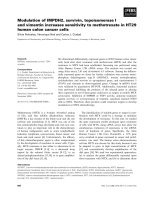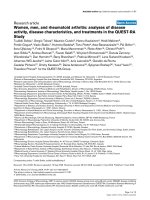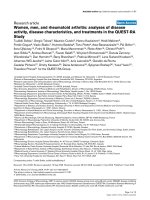ynthesis of novel activity based probes and combinatorial peptide libraries to profile proteases
Bạn đang xem bản rút gọn của tài liệu. Xem và tải ngay bản đầy đủ của tài liệu tại đây (937.98 KB, 154 trang )
SYNTHESIS OF NOVEL ACTIVITY BASED PROBES AND
COMBINATORIAL PEPTIDE LIBRARIES TO PROFILE
PROTEASES
RESMI CHANDRASEKHARA PANICKER
NATIONAL UNIVERSITY OF SINGAPORE
2007
SYNTHESIS OF NOVEL ACTIVITY BASED PROBES AND
COMBINATORIAL PEPTIDE LIBRARIES TO PROFILE PROTEASES
RESMI CHANDRASEKHARA PANICKER
(M. Sc. - Mahatma Gandhi University, Kerala, India)
A THESIS SUBMITTED
FOR THE DOCTOR OF PHILOSOPHY DEGREE
DEPARTMENT OF CHEMISTRY
NATIONAL UNIVERSITY OF SINGAPORE
2007
i
ACKNOWLEDGEMENTS
I wish to thank to my supervisor Associate Professor Yao Shao Qin for his novel ideas,
patient guidance and invaluable suggestions during the course of my research.
I am grateful to my project partners Liau Minglee, Eunice, Haung Xuan and Wang Gang
as well as other lab-mates Aparna, Souvik, Mahesh, Dawn, Wang Jun, Hong Yan, Elaine,
Grace and Hu Yi for all their help during the course of the project.
Special thanks to my fellow-colleague plus life-partner Raja for his kind support and
encouragement in all ways possible.
I appreciate the support of the laboratory staff from the NMR and the MS labs for
providing me the necessary training and technical assistance.
I am also grateful to the National University of Singapore, for granting the research
scholarship.
Last but not least, I would like to express my sincere thanks to my parents, grandmother,
other family members and friends for their constant support and well wishes.
ii
TABLE OF CONTENTS
Acknowledgements i
Table of contents ii
Summary vi
List of tables viii
List of figures ix
List of schemes xii
Abbreviations xiii
Publications xvii
Chapter 1 Introduction
1.1 Proteomics 1
1.2 Conventional techniques for protein profiling 2
1.3 Activity based protein profiling 4
1.3.1 Activity-based probes 6
1.3.2 A few developments from our lab using activity 11
based/affinity based approaches
1.4 Combinatorial peptide libraries 13
1.4.1 Peptide Library on Solid Support 14
iii
1.4.2 Parallel synthesis 15
1.4.3 Split and mix synthesis 16
1.4.4 Reagent mixture synthesis 17
1.4.5 Positional scanning peptide libraries 17
1.5 Bioimaging 18
Chapter 2 Design and Synthesis of activity-based probes targeting caspases 25
2.1 Introduction 25
2.1.1 Caspases 25
2.1.2 Mechanistic details of interaction of caspases with their substrates 27
2.2 Affinity tag approach to develop caspase probe for an in vitro proteomic
Experiment 28
2.2.1 Design of the caspase-Cy3 probe 30
2.2.2 Chemical synthesis of the caspase-Cy3probe 33
2.2.3 Results and conclusions of the in vitro experiments 36
2.3 Activity based affinity probes for in vivo labeling of caspases 39
2.3.1 Design of cell permeable caspase probes 39
2.3.2 Chemical synthesis of cell permeable caspase probes 42
2.3.3 Results and conclusions of the in vivo labeling experiments 44
2.4 Experimental details of the synthesis of the caspase probes 47
iv
Chapter 3 Positional Scanning Peptide libraries of Fluorogenic substrates to map
the substrate specificity of Proteases 58
3.1 Introduction 58
3.2 Design of our fluorogenic peptide library 60
3.3 Synthetic details of the ACC-library 62
3.4 Quality analysis of library 67
3.5 Fingerprinting experiments using ACC library 68
3.6 Data analysis and conclusions 68
3.7 ACC-azide library 71
3.8 Chemical synthesis of the azido-ACC-peptides 71
3.9 Experimental details of Syntheses 72
3.9.1 Experimental details of synthesis of ACC-Positional scanning library 72
3.9.2 Experimental details of synthesis of azido-ACC peptides 81
Chapter 4 Fingerprinting of metalloproteases and cysteine proteases
using positional scanning peptide libraries 84
4.1 Affinity based fingerprinting of metalloproteases using a positional scanning
inhibitor library of peptidyl hydroxamates 84
4.1.1 Synthesis of the peptidyl hydroxamate library 86
4.1.2 Gel-based inhibition experiments using the peptidyl hydroxamate library 87
4.2 Activity based fingerprinting of cysteine proteases using a positional scanning
library of peptide vinyl sulfone probes 89
v
4.2.1 Synthesis of the vinyl sulfone library 91
4.2.2 Results and conclusions from the labeling experiments 93
4.3 Experimental details of the synthesis 94
4.3.1 Experimental details of the synthesis of the peptide hydroxamate library 94
4.3.2 Experimental details of the synthesis of the vinyl sulfone library 98
Chapter 5 Synthesis of Molecular probes for potential bioimaging experiments 107
5.1 Introduction 107
5.2 Design of the NTA probes 108
5.3 Chemical synthesis of the probes 109
5.4 Results and conclusions of the labeling experiments 111
5.5 Experimental details of the synthesis of NTA probes 113
Chapter 6 References 114
Chapter 7 Appendices 129
Capase-Fluorescein probe (16) –
1
H NMR 129
Capase-Fluorescein probe (16) – ESI-MS 130
Capase-Biotin probe (18) –
1
H NMR 131
Capase-Biotin probe (18) – ESI-MS 132
AVLQ-ACC-Lys(N
3
) – ESI-MS 133
NTA-TMR (57) - ESI-MS 134
NTA-FL (59) - ESI-MS 135
vi
SUMMARY
The work presented in this thesis focus mainly on two areas (i) designing specific
probes to target a particular class of proteases using activity based affinity tag approach
(ii) collection of substrate specificity/binding data of proteases using positional scanning
peptide libraries.
Chapter 2 of the thesis present our efforts towards the design and synthesis of
small molecule probes to target caspases, enzymes which play a key mediating role in
apoptosis or programmed cell death. At first, we synthesized a fluoromethyl ketone
containing activity-based probe that specifically target caspases in an in vitro proteomic
experiment. Later on, we extended this approach to the in vivo labeling of caspases in
apoptotic HeLa cells by the use of modified probes which are cell permeable. The
attractive feature of our strategy is that it allows for the large scale identification of novel
enzyme-associating proteins.
Chapter 3, 4 and 5 mainly focus on the synthesis of positional scanning
combinatorial libraries of peptide substrates/inhibitors to profile proteases. These works
concentrate on the studies of the substrate specificity or “fingerprinting” of various
classes of proteases. For example, a positional scanning library of 7-amino-4
carbamoylmethylcoumarin (ACC) conjugated peptides were synthesized and assayed
against different classes of proteases. The substrate specificity profiles of various classes
of proteases were successfully obtained using this library. Other efforts include the
activity-based profiling of cysteine proteases using a twenty member library of vinyl
sulfone-containing peptides with varying P
1
position and the synthesis of a positional
vii
scanning combinatorial library of peptidyl hydroxamates to investigate the substrate
specificity of metalloproteases at the P
2
-P
4
positions.
A brief attempt for bioimaging using small molecular probes also has been done
as illustrated in chapter 6.
Selected NMR and MS spectra are listed in the Appendices.
viii
LIST OF TABLES
Table 1 Proteins identified by mass spectrometry 47
Table 2 Optimization of conditions for ACC coupling 65
Table 3 ESI-MS data of the ACC-conjugated peptide azides 83
Table 4 ESI-MS data for vinyl sulfone library 105
ix
LIST OF FIGURES
1. Fig. 1 Schematic representation of activity-based profiling strategy 6
2. Fig. 2 General structure of an activity-based probe 7
3. Fig. 3 Examples of reactive units used for activity based profiling 8
4. Fig. 4 Examples of linkers used for activity based profiling 9
5. Fig. 5 Examples of reporter tags used for activity based profiling 10
6. Fig. 6 (a) Principle of activity-based detection of enzymes in a
microarray. (b) Mechanism-based probes used for detection of phosphatases
(PT-Cy3), cysteine (VS-Cy3) and serine (FP-Cy3) proteases 12
7. Fig. 7 Strategy for photoaffinity labeling 13
8. Fig. 8 Schematic representation of parallel synthesis 15
9. Fig. 9 Schematic representation of split and mix synthesis 16
10. Fig. 10 Schematic representation of positional scanning library 18
11. Fig. 11 (a) Site-specific labeling of tetracysteine motif by FlAsH
(b) Mechanism of labeling of hAGT fusion proteins with BG
derivative (c) Labeling mechanism of thioester probe with the
N-terminal cysteine proteins in live cells (d) NTA probe coordinating
to Ni (II) ion (e) Labeling of fusion proteins based on interactions. 24
12. Fig. 12 Catalytic mechanism of caspases 28
x
13. Fig. 13 Structure of the caspase-Cy3 probe 29
14. Fig. 14 The proposed inhibition pathways for halomethyl ketones 31
15. Fig. 15 Comparison of the length of the alkyl linker with that of the
P
2
-P
4
tripeptide sequence of a typical tetrapeptide FMK inhibitor 32
16. Fig. 16 SDS-page results of labeling using the caspase-Cy3probe 37
17. Fig. 15 (a) The cell permeable FMK probes (b) Schematic
representation of the labeling strategy 41
18. Fig. 18 Results of the labeling experiments with FMK-FL and FMK-biotin 46
19. Fig. 19 (a) Schematic representation of the fingerprinting strategy
(b) Amino-conjugated ACC substrates yielding free ACC upon enzymatic
cleavage 62
20. Fig. 20 Fingerprint profiles of proteases obtained using ACC library 70
21. Fig. 21 (a) MMP inhibitor library (b) The photoaffinity probe
used for labeling 86
22. Fig. 22 (a) Images of the gel-based inhibition experiments with
representative members of the PS library (b) Plot of IC50 values from
dose-dependent inhibition experiments of thermolysin labeling by
affinity probe in the presence of varying concentrations of peptides
from the positional scanning library 89
xi
23. Fig. 23 Mechanism of peptide vinyl sulfone inhibiting cysteine proteases 90
24. Fig. 24 Positional scanning library of peptide vinyl sulfones 91
25. Fig. 25 SDS-page results of labeling of four proteases using VS probes 93
26. Fig. 26 IC
50
plots of two representative members of the PS library 97
27. Fig. 27 The NTA probes and the mechanism of labeling of histidine
tagged proteins by NTA-TMR probes 109
xii
LIST OF SCHEMES
Scheme 1 Synthetic route for FMK-Cy3 probe 35
Scheme 2 Synthetic route for Cy3-NHS 36
Scheme 3 Synthetic route for Fluorescein diacetate-NHS 43
Scheme 4 Synthetic route for FMK-FL and FMK-TMR probes 44
Scheme 5 Synthesis of K(Biotin) 62
Scheme 6 Synthesis of Fmoc-ACC 63
Scheme 7 Synthesis of Rink-ACC resin 64
Scheme 8 Synthesis of the ACC conjugated positional scanning library 67
Scheme 9 Synthesis of azido-ACC conjugates 72
Scheme 10 Synthetic route for the peptidyl hydroxamate library 87
Scheme 11 Synthesis of the vinyl sulfone library 92
Scheme 12 NTA synthesis 110
Scheme 13 Synthesis of NTA-FL and NTA-TMR 111
Scheme 14 The strategy of labeling target proteins with NTA probes 112
xiii
ABBREVIATIONS
AA Amino acid
ACC 7-Aminocoumarin-4-acetic Acid
Ala Alanine
Arg Arginine
Asp Aspartic acid
Asn Asparagine
Boc tert-Butoxycarbonyl
br Broad
tBu tert-Butyl
Cy3 Cyanine dye3
Cys Cysteine
δ Chemical shift
Da Dalton
DBU 1,8-Diazobicyclo[5.4.0]undec-7-ene
DCC N, N’-Dicyclohexylcarbodiimide
DCM Dichloromethane
dd Doublet of doublet
DIC N, N’-diisopropylcarbodiimide
DIEA N, N’-diisopropylethylamine
DMAP 4-Dimethylaminopyridine
DMF Dimethylformamide
DMSO Dimethylsulfoxide
xiv
DTT Dithiothreitol
EA Ethyl acetate
EDC 1-Ethyl-3-(3-dimethylaminopropyl)carbodiimide HCl
EDTA Ethylenediaminetetracetic acid
ESI Electron Spray Ionization
Gly Glycine
Gln Glutamine
Glu Glutamic acid
Fmoc 9-Fluorenylmethoxycarbonyl
HATU O-(7-azabenzotrizol-1-yl)-1,1,3,3,tetramethyluronium
hexafluorophosphate
His Histidine
HOBT N-Hydroxybenzotriazole
HPLC High Performance Liquid Chromatography
Hz Hertz
Ile Isoleucine
Leu Leucine
Lys Lysine
LHMDS Lithium bis(trimethylsilyl)amide
m Multiplet
m-CPBA m-Chloroperbenzoic acid
Met Methionine
min Minute
xv
mm Multiplet
mmol Millimole
MMP Matrix metalloproteases
MS Mass spectrometry
NHS N-Hydroxysuccinimide
nM Nanomolar
NMR N-Methylpyrrolidinone
NMP N-methylpyrrolidone
Orn Ornithine
PSL Positinal scanning library
Phe Phenyl alanine
Pro Proline
q Quartet
RBF Round bottom flask
r.t. Room temperature
s Singlet
SDS-PAGE Sodium dodecyl sulfate-polyacrylamide gel electrophoresis
Ser Serine
t Triplet
TBTU O-(Benzotriazol-1-yl)-N,N,N’,N’-tetramethyluronium
tetraborofluorate
TFA Trifluoroacetic acid
THF Tetrahydrofuran
xvi
Thr Threonine
Trp Tryptophan
Tyr Tyrosine
TLC Thin layer chromatography
Tris Trishydroxymethylamino methane
uv Ultraviolet
Val Valine
VS Vinyl sulfone
Z Benzyloxycarbonyl or Cbz
xvii
PUBLICATIONS
1. Uttamchandani, M., Liu, K., Panicker, R.C., Yao, S.Q. Chem. Commun. 2007, 1518.
2. Sun, H., Panicker, R.C., Yao, S.Q. Biopolymers. 2007, 88, 141.
3. Panicker, R.C., Chattopadhaya, S., Yao, S.Q. Analy. Chim. Acta. 2006, 556, 69.
4. Tan, E.L.P., Panicker, R.C., Chen, G.Y.J., Yao, S.Q. Chem. Commun. 2005, 596.
5. Chan, E.W.S., Chattopadhaya, S., Panicker, R.C., Huang, X., Yao, S.Q. J. Am. Chem.
Soc. 2004, 126, 14435.
6. Panicker, R.C., Huang, X., Yao, S.Q. Comb. Chem. High Throughput Screening.
2004, 7, 547.
7. Yeo, D.S.Y., Panicker, R.C., Tan, L.P., Yao, S.Q. Comb. Chem. High Throughput
Screening. 2004, 7, 213.
8. Liau, M.L., Panicker, R.C., Yao, S.Q. Tetrahedron Lett. 2003, 44, 1043.
9. Tan, E.L.P., Panicker, R.C., Tan, L.P., Chattopadhaya, S., Yao, S.Q. “Developing
chemical biology tools for the study of functional proteomics”. Proceedings of the 1
st
international symposium on Biomolecular chemistry , 2003, Japan
1
Chapter 1 Introduction
1.1 Proteomics
Proteomics studies proteins, their structures, localizations, post-translational
modifications, functions and interactions with other proteins. The mapping of protein
structure-function holds the key for better understanding of cellular functions under both
normal and diseased states, which is critical for modern drug discovery. The completion
of the Human Genome Project has no doubt been a major achievement in scientific
research, opening up new and exciting possibilities to fully map and characterize all
proteins expressed in cells [1]. However, the study of human proteome presents scientists
with a task much more daunting than the human genome project. Functional assignment
to these immense numbers of novel genes and gene products has become essential. In
fact, the estimated > 100,000 different proteins expressed from 30000-40000 human
genes make it extremely challenging, if not impossible with existing protein analysis
techniques, to map the entire cellular functions at the translational level. Consequently,
there have been rapid advances in the techniques and methods capable of large-scale
proteomic studies. Among them, the recently developed high-throughput screening
methods have enabled scientists to analyze proteins quickly and efficiently at an
organism-wide scale. Since last couple of years our group has been focusing on the
development or fine-tuning of the various methods for protein profiling, [2-29] a handful
of which will be described in the coming sections of this thesis.
2
1.2 Conventional techniques for protein profiling
The conventional two-dimensional gel electrophoresis (2D-GE), in combination
with advanced mass spectrometric techniques, has facilitated the rapid characterization of
thousands of proteins in a single polyacrylamide gel. The technique has the ability to
separate thousands of proteins in a specific cell or tissue, including their posttranslational
modified forms. Thus the method is well suitable for the global analysis of protein
expression in an organism. This, together with the newly developed activity-based
profiling approaches that target different classes of proteins, has now allowed the study of
protein functions based on their intrinsic enzymatic activities [5, 9]. However, 2D-GE
suffers from a number of long-standing problems, including low throughput, a limited
dynamic detection range, poor reproducibility, low sensitivity, as well as its difficulties in
analyzing hydrophobic, small, and very basic or acidic proteins. Incremental
improvements in the 2D-GE technology, including the use of sensitive staining methods
and higher-resolving gels, and sample fractionation prior to 2D-GE, have alleviated some
of these problems [30, 31]. Differential gel electrophoresis (DIGE) [32] and multiplexed
proteomics approach (MP approach) [33] are some other recent developments related to
2D-GE. Yates and co-workers introduced a multidimensional protein identification
technology (MudPIT) [34]. In this technique, multiple types of columns are coupled
together to separate proteins using different physiochemical properties in addition to
molecular weights and charges, thereby extending the analytical range to proteins having
high or low molecular weights, as well as low-abundance and insoluble proteins. MudPIT
also allows the flexibility of incorporating a suitable affinity column to enable selective
analysis of protein complexes and protein-protein interactions.
3
An elegant chemical method for quantitative proteomics has been developed by
Gygi et al in 1999. Among different isotope-based proteomics techniques, the isotope-
coded affinity tagging (ICAT™) approach utilizes stable-isotope labeling to perform
quantitative analysis of paired protein samples, followed by separation and identification
of proteins within the complex mixtures with liquid chromatography and mass
spectrometry [35]. The method relies on the use of an affinity based approach which
permits the quantitative comparison of protein abundances between complex proteomes
by MS analysis. Instead of resorting to conventional protein-staining methods for
quantification, the authors have used a chemical probe composed of a reactive group
capable of covalently binding to a defined subset of amino acid side chains, an
isotopically coded linker and an affinity tag for the isolation of reactive peptides. More
recently, the gel-based ICAT has also been reported [36]. The ICAT approach is able to
simplify the analysis of the proteome mixture by two orders of magnitude based on the
occurrence of cysteine in proteins (1.7 %). However, the strategy is limited to probing
known proteins containing cysteine residues and depends on non-specific binding to CAT
reagents.
From the very beginning of the proteomic era, mass spectrometry (MS) has
played a major role in the high-throughput identification of proteins following separation
techniques such as 2D-GE, ICAT, etc. With the advent of the ‘soft’ ionization techniques
such as ESI and MALDI coupled with various mass analyzers including the ion trap,
time-of-flight (TOF), quadrupole and Fourier transform ion cyclotron (FT-MS), the
analysis of large intact protein complexes is now possible [37], thus providing
complementary data to that obtained by well-established methods in structural biology
4
such as electron microscopy, X-ray crystallography and NMR. Another MS-based
technology for quantitative analysis of protein mixtures is known as the surface-enhanced
laser desorption ionization-time of flight (SELDI-TOF) [38]. This technique utilizes
stainless steel or aluminum-based supports, or chips, engineered with chemical or
biological bait surfaces that allow differential capture of proteins (based on the intrinsic
properties of proteins). After the removal of non-specifically adhered proteins, the bound
proteins are laser-desorbed and ionized for MS analysis. This field is currently being
developed as a prominent technique when combined with advances in protein chip
technology.
1.3 Activity based protein profiling
As far as most enzymes are concerned, the overall protein expression levels do
not strictly comparable to their activity profiles. Different enzymes have intrinsically
different catalytic activities. Moreover, various post translational modifications such as
phosphorylation, glycosilation, acteyilation etc, action of endogeneous
activators/inhibitors, factors like p
H
and other native conditions significantly influence
catalytic activity of enzymes. Most of the aforementioned methods, like 2DE-MS, still
focus on measuring the changes in protein abundance and hence provide only an indirect
estimate of dynamics in protein function. Undeniably, several important forms of post-
translational regulation, as well as protein–protein and protein–small-molecule
interactions [39], may escape detection by these proteomic methods. In order to
accomplish the functional analysis of proteins, a number of proteomic methods have been
introduced in the past aiming to characterize the activity of proteins on a global scale.
Large-scale yeast two-hybrid screens [40, 41] and epitope-tagging immunoprecipitation
5
experiments [42, 43] are some of the methods which are widely used to study protein-
protein interactions. Although these methods do have the benefit of assigning specific
molecular functions to individual protein products, they normally depend on recombinant
expression of proteins in non-natural environments and, therefore, do not directly
evaluate the functional state of these biomolecules in their native settings.
Recently developed activity-based protein profiling (ABPP) has opened up new
ways of answering some of the challenges associated with proteomic research. The
activity/affinity-based methods make use of small molecule/peptide based chemical
probes to profile the functional state of enzyme families directly within a complex
proteome. These probes are developed using tools of synthetic organic chemistry and
have become a major attraction in the field of high-throughput functional proteomics.
Originally developed by Cravatt et al., ABPP allows the proteases present in a crude
proteome to be studied on the basis of their enzymatic activities rather than their relative
abundance [44-49]. The major advantage of the protein activity-based chemical
approaches for profiling proteins includes the ability to target low abundance and
membrane associated proteins with samples of high complexity. The strategy is able to
bridge the gap between technologies such as the protein microarray and 2D-GE based
techniques which study endogenous proteins by their expression, and combine the high-
throughput feature of 2D-GE with the ability of function-based protein studies. The
general strategy in activity-based profiling typically involves a small molecule-based,
active site-directed probe which targets a specific class of enzymes based on their
enzymatic activity. Thus, the activity-based approach can potentially filter out proteins
that are not of interest and focus on certain classes of proteins. For example, Fig. 1 shows
6
a general approach to activity-based enzyme profiling using a fluorescent activity-based
probe. Among the different enzymes present in a complex proteome, the probe
selectively labels a particular class of active enzymes. The labeled enzymes can be
separated by SDS-PAGE and visualized by fluorescent imaging, which could be further
characterized by mass spectrometry.
Fig. 1 Schematic representation of activity-based profiling strategy
1.3.1 Activity-based probes
Activity-based probes are designed based on their potential application in
proteomics. The design of these probes depends largely on the nature/complexity of the
system we are looking at as well as the type of information we intend to gather. Highly
specific probes offer invaluable insights into the topology of the enzyme active site and
the catalytic mechanism of a particular enzyme/sub-class of enzymes. Hence they are
very useful in the design of specific inhibitors. On the contrary, broad-spectrum probes
can label most proteins having the same kind(s) of activity and hence find more
application in high-throughput activity/affinity based profiling of different classes of
enzymes on a global scale. They typically are suicide/mechanism-based or affinity-based
chemical probes which get covalently attached to particular classes of enzymes, thus
allowing for the large-scale protease identification, characterization, as well as
fingerprinting experiments [22, 28, 29]. Although affinity based probes are not strictly
A
A
B
B
B
B
C
C
C
C
D
D
E
E
E
E
A
A
D
D
A
D
C
A
E
B
Enzyme
Activity
Based
Enzyme
SDS-Page
Fluorescent
Imaging









